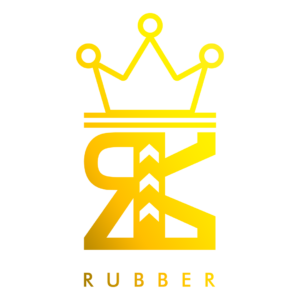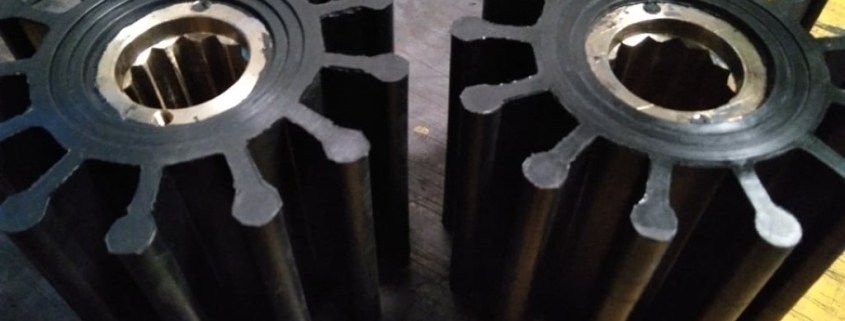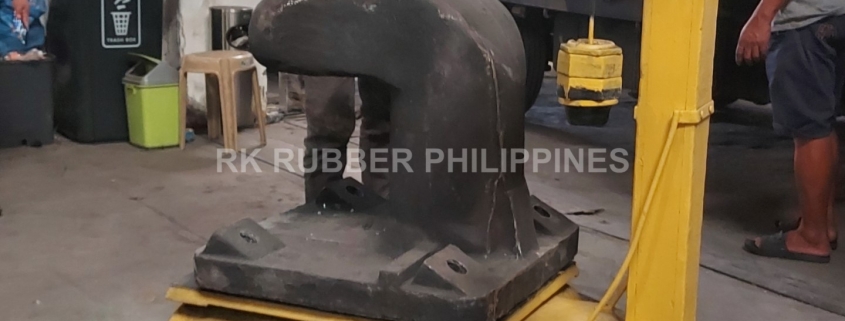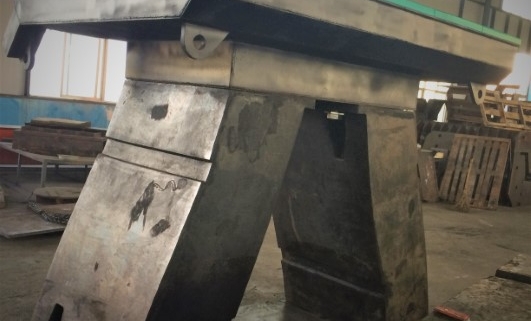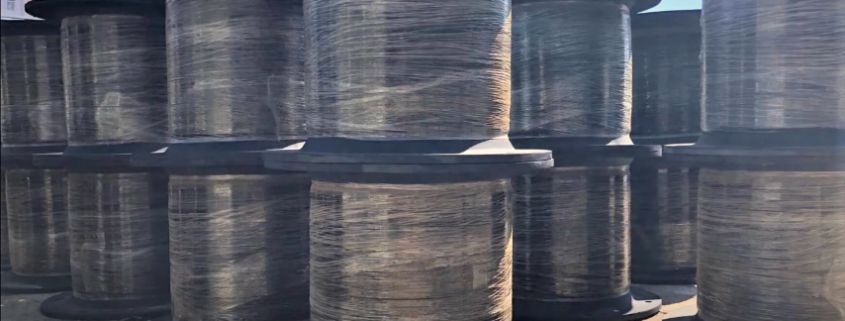Mooring Bollard Manufacturer in the Philippines
in Rubber ProductWith maritime safety being a top priority, the choice of a reliable mooring bollard manufacturer is crucial for port operations. RK Rubber Enterprise Co. stands out as a reputable player in the field, offering a range of top-notch mooring solutions tailored to meet diverse needs. Their expertise in crafting durable, weather-resistant bollards that ensure vessel security is unmatched in the industry. Considering the significance of this maritime equipment, exploring the intricacies of mooring bollard manufacturing in the Philippines could shed light on the essential considerations for port authorities and marine industry stakeholders alike.
Key Points
- RK Rubber Enterprise Co. manufactures mooring bollards in the Philippines.
- Offers customization options for specific needs.
- Competitive pricing compared to market standards.
- Proven track record of customer satisfaction.
- Diverse range of products and services available.
Importance of Mooring Bollards
Mooring bollards are crucial for ensuring the safety and security of vessels in ports. Their durability, weather resistance features, and specific load capacity play significant roles in maintaining the integrity of maritime operations. With bollards capable of withstanding extreme conditions and heavy loads, they are essential components of any port infrastructure.
Durability of Bollards
Ensuring the durability of bollards is paramount for maintaining the safety and security of vessels at ports and docks. The benefits of durable bollards include longevity, quality, and reliability, reducing the need for frequent maintenance. High-quality materials and efficient installation contribute to the cost-effectiveness of bollards over time. Customization options allow for tailored solutions to specific mooring requirements, enhancing overall efficiency.
Proper maintenance is key to maximizing the lifespan of bollards, ensuring they can withstand various weather conditions and heavy loads. By prioritizing durability in mooring bollards, ports and docks can guarantee a secure and stable environment for vessels, promoting smooth operations and minimizing potential risks.
Weather Resistance Features
With an emphasis on durability and reliability, weather resistance features are essential components of mooring bollards to ensure optimal performance in various environmental conditions. Mooring bollards are equipped with corrosion protection and material durability to withstand harsh marine environments. The installation process considers impact resistance, ensuring structural integrity during vessel mooring. Customization options allow for tailored solutions to specific port requirements. These features collectively enhance the longevity and functionality of the mooring bollards, providing a robust solution for securing vessels in different weather conditions.
Load Capacity Specifics
An essential aspect to consider when evaluating mooring bollards is their specific load capacity, a critical factor that directly impacts their effectiveness in securing vessels at ports. The load capacity determines the maximum weight the bollard can safely handle, ensuring the safety of the moored vessels. When selecting a mooring bollard, it is crucial to assess the load capacity based on the types of vessels that will be secured.
Additionally, understanding the installation process, available material options such as high-quality cast steel or iron, maintenance tips, and customization options is vital for optimal performance and longevity of the bollards. Regular maintenance, including inspections for wear and tear, ensures that the bollards remain reliable and secure for mooring operations.
Manufacturing Process and Materials
The manufacturing process of mooring bollards by RK Rubber Enterprise Company in the Philippines involves utilizing high-quality cast steel or iron to ensure exceptional load capacity and durability. These materials are selected for their strength, reliability, and corrosion resistance, making the bollards suitable for various mooring applications. To guarantee quality, the company conducts rigorous product testing and follows construction techniques that prioritize durability and weatherproofing.
Customers have customization options to tailor the bollards to their specific needs. The installation process includes different mounting solutions, and optional protective coatings can be applied to enhance longevity. With a focus on design flexibility and aesthetic appeal, the bollards are reinforced with high-quality materials like metal, concrete, or rubber. This meticulous approach results in robust mooring bollards capable of handling extreme weights up to 220 tons, meeting the highest industry standards.
Types of Mooring Bollards
Different types of mooring bollards serve various functions and applications in maritime operations, each designed with specific features to meet diverse mooring requirements efficiently.
- Tee Head Mooring Bollards, typically made of cast iron or steel, are robust and commonly used to secure vessels by anchoring bow and stern lines.
- Pillar Type Bollards, usually constructed from steel, serve as posts for mooring ships to docks or piers.
- Double Bitt Type Bollards, formed by two connected posts, are effective barriers against vehicle intrusion.
- Cleat Type Bollards feature a horizontal cleat for rope or chain securing, either made of steel or concrete and available in permanent or removable designs.
- Single Bitt Bollards, crafted from high-strength materials, are versatile and ideal for various mooring setups.
- Kidney Type bollards, economical and prevalent in marine settings, are easy to install and adaptable to low to medium tidal ranges. These bollards come in various materials, offer customization possibilities, adhere to industry standards, and require proper installation and maintenance for optimal performance.
Key Features of Our Products
Crafted with exceptional durability and high load capacity, our mooring bollards feature robust designs to ensure secure and reliable mooring solutions for diverse maritime applications. The key features of our products include heavy-duty construction with an outstanding load capacity of up to 220 tons, made from high-quality cast steel or iron, providing excellent corrosion resistance and weather resilience. Our bollards offer different mounting solutions and optional protective coatings for enhanced longevity. They are reinforced with high-quality materials such as metal, concrete, or rubber, ensuring reliability in various mooring scenarios.
Additionally, our mooring bollards come in a wide range of selections and can be customized to meet specific requirements. With a compact and robust design, these bollards can withstand extreme weights and are suitable for a multitude of maritime applications, making them a top choice for ensuring the safety and security of vessels in ports and harbors.
Applications and Benefits
With a focus on enhancing maritime safety and efficiency, our mooring bollards are designed to provide secure and reliable solutions for a wide range of applications. Our mooring bollards are versatile and can be utilized in various settings such as ports, docks, marinas, and terminals. The installation techniques for our bollards are straightforward, ensuring a quick and efficient setup process. Maintenance tips include regular inspections for wear, tear, and corrosion, ensuring longevity and optimal performance.
We offer customized designs to meet specific requirements and industry standards, guaranteeing compliance with safety regulations. Case studies demonstrate the effectiveness of our mooring bollards in different scenarios, showcasing their durability and reliability in real-world applications. By choosing our mooring bollards, customers benefit from increased security, reduced risks of vessel damage, and improved operational efficiency in maritime environments.
Choosing RK Rubber Enterprise Co. As Your Manufacturer
Why consider RK Rubber Enterprise Co. as your mooring bollard manufacturer? RK Rubber Enterprise Co. stands out for its customized solutions tailored to meet your specific needs. With competitive pricing, you can trust that you are getting value for your investment without compromising on quality. The company prides itself on reliable service, ensuring that your mooring bollards are durable and efficient. Expert craftsmanship is at the core of RK Rubber Enterprise Co., guaranteeing precision and attention to detail in every bollard produced.
The company emphasizes timely delivery, so you can rely on receiving your mooring bollards promptly to keep your operations running smoothly. By choosing RK Rubber Enterprise Co. as your manufacturer, you are opting for a partner that prioritizes excellence in every aspect of the manufacturing process.
Frequently Asked Questions
What Are the Maintenance Requirements for Mooring Bollards?
To maintain mooring bollards, ensure regular rust prevention and inspections, lubrication, and cleaning. Perform paint touch-ups and repairs promptly to control corrosion and ensure durability. Implement safety measures and timely replacements for optimal functionality.
Are Mooring Bollards Customizable to Specific Requirements?
Customization options for mooring bollards offer design flexibility, various material choices, size variations, and special features tailored to specific requirements. This ensures optimal functionality and durability, meeting individualized needs for secure vessel mooring.
Can Mooring Bollards Withstand Harsh Weather Conditions?
Mooring bollards are built for resilience, with exceptional corrosion resistance and material durability to withstand harsh weather conditions. Their impact resistance and weatherproof design ensure reliable performance even in extreme conditions.
How Do I Know Which Type of Mooring Bollard Is Suitable for My Needs?
To determine the suitable mooring bollard, consider material options like cast steel or iron, assess weight capacity requirements, explore design variations such as tee head or pillar type, prioritize corrosion resistance properties, and ensure a straightforward installation process.
Do You Provide Installation Services for Mooring Bollards?
Yes, installation services for mooring bollards are provided. Our professional team ensures a meticulous installation process, dispels common misconceptions, emphasizes safety precautions, discusses cost considerations, and offers DIY options where applicable for a comprehensive service experience.
Conclusion
In conclusion, RK Rubber Enterprise Co. stands out as a premier mooring bollard manufacturer in the Philippines, offering high-quality, durable, and customizable solutions for maritime mooring needs. With a focus on reliability, excellence in manufacturing, and commitment to customer satisfaction, RK Rubber is a trusted partner in ensuring the safety and security of vessels in ports. Choose RK Rubber for innovative products, competitive pricing, and industry-standard solutions.
Cell Rubber Dock Fender
in UncategorizedCell Rubber Dock Fender Overview
Characterized by their unique geometrical shape and exceptional energy absorption capabilities, Cell Rubber Dock Fenders have become an essential component in the marine sector. Their primary function is to protect both vessels and docking infrastructure by absorbing and dispersing kinetic energy generated during berthing. This notably reduces the risk of damage to both the ship and the dock, guaranteeing safe mooring operations and enhancing marine safety.
The specific shape of a Cell Rubber Dock Fender is circular, allowing it to distribute impact pressure and weight evenly, providing superior impact absorption. This design enhances the fender’s ability to absorb collision energy equally from all directions, increasing its efficiency in protecting both vessels and docking infrastructure. Cell fender applications are diverse, including berths, dolphin wharfs, offshore docks, and terminals. By optimizing impact distribution, Cell Rubber Dock Fenders minimize the risk of damage and guarantee safe docking operations. Their exceptional energy absorption capabilities make them an indispensable component in maintaining marine safety and efficiency. With their robust design and versatility, Cell Rubber Dock Fenders are a popular choice for various marine applications.
Key Features and Manufacturing
Through a combination of advanced materials and precise engineering, Cell Rubber Dock Fenders are manufactured to provide exceptional energy absorption and low reaction force, thereby enhancing maritime safety. The manufacturing process involves the use of high-quality rubber compounds that are carefully selected for their durability and impact resistance.
During production, molding techniques are employed to shape the fenders into desired sizes and configurations. The vulcanization process is then applied to enhance the strength and durability of the rubber. This process involves exposing the rubber to high temperatures and pressures, resulting in a more resilient and long-lasting product.
To guarantee the quality of the fenders, stringent quality control measures are implemented throughout the production process. This includes regular inspections and testing to ensure compliance with specifications. Key features of Cell Rubber Dock Fenders include:
- Advanced Molding Techniques: Utilized to create fenders with precise shapes and sizes.
- Vulcanization Process: Enhances the strength and durability of the rubber compounds.
- Stringent Quality Control: Ensures that all fenders meet the required specifications and standards.
Benefits of Cell Rubber Fenders
Cell rubber dock fenders offer numerous benefits, including enhanced durability and longevity, exceptional energy absorption capabilities, and cost-effective solutions. These fenders are designed to withstand harsh maritime conditions, providing impact resistance and reducing the risk of damage to vessels and docking infrastructure. By leveraging advanced materials and manufacturing processes, cell rubber dock fenders deliver a reliable and efficient solution for maritime operations.
Durability and Longevity
The robust design of cell rubber dock fenders, combined with the use of high-quality rubber compounds and a rigorous manufacturing process, enables them to withstand the harsh conditions and heavy usage typical in maritime environments. This durability guarantees that cell rubber dock fenders can withstand the impacts of vessel traffic, weather conditions, and exposure to saltwater and extreme temperatures.
Their ability to resist material degradation and maintain peak performance over time is directly linked to the quality of the rubber compounds used and the manufacturing process. Furthermore, proper installation techniques play a vital role in extending the lifespan of cell rubber dock fenders, as they help prevent damage and wear caused by incorrect setup.
In terms of environmental impact, cell rubber dock fenders demonstrate exceptional resistance to marine growth and fouling, reducing the need for frequent cleaning and maintenance. Here are some key benefits of their durability and longevity:
- Prolonged material performance: High-quality rubber compounds maintain their integrity over time.
- Reduced maintenance needs: Durable design minimizes the need for frequent cleaning and repairs.
- Environmental sustainability: Resistance to marine growth and fouling reduces the environmental impact of cell rubber dock fenders.
Energy Absorption Capabilities
Numerous maritime operations rely on the exceptional energy absorption capabilities of cell rubber dock fenders to safeguard vessels and docking infrastructure from damage. The unique design of these fenders enables them to effectively distribute impact energy, guaranteeing the safety of both the vessel and the docking structure. The circular shape of cell rubber dock fenders allows for even pressure distribution, ideal energy absorption, and enhanced durability.
The energy absorption capabilities of cell rubber dock fenders are a result of design optimization, where the fender’s geometric shape is carefully engineered to maximize energy efficiency. This design feature enables the fender to absorb and dissipate energy uniformly, reducing the risk of damage to both the vessel and the docking structure. Performance metrics such as energy absorption capacity, reaction force, and durability are carefully considered in the design and manufacturing process to guarantee that cell rubber dock fenders meet the highest standards of safety and efficiency. By leveraging the energy absorption capabilities of cell rubber dock fenders, maritime operations can guarantee safe and efficient docking operations.
Cost-Effective Solutions
By optimizing energy absorption and minimizing reaction force, cell rubber dock fenders greatly reduce the risk of damage to vessels and docking infrastructure, resulting in substantial cost savings. This is particularly significant in the maritime industry, where maintenance and repair costs can be substantial. By investing in high-quality cell rubber dock fenders, operators can enjoy long-term cost savings and enhanced operational efficiency.
The cost-effectiveness of cell rubber dock fenders can be attributed to their durable design and low maintenance requirements. Here are three key benefits:
- Extended lifespan: Cell rubber dock fenders have a longer lifespan compared to other types of fenders, reducing the need for frequent replacements and associated costs.
- Reduced maintenance: The durable design of cell rubber dock fenders minimizes the need for regular maintenance, freeing up resources for other critical operations.
- Improved operational efficiency: By reducing the risk of damage to vessels and docking infrastructure, cell rubber dock fenders enable operators to optimize their docking operations, resulting in enhanced investment returns and improved overall efficiency.
Impact Resistance Features
Impact resistance is an essential feature of cell rubber dock fenders, enabling them to effectively mitigate the effects of vessel collisions with docking infrastructure. The superior impact resistance of these fenders is attributed to their robust design and high-quality rubber compounds, which provide exceptional durability and energy absorption capabilities.
Cell rubber dock fenders are subjected to rigorous performance testing, including impact resistance evaluations, to guarantee they meet stringent safety and performance standards. These tests simulate real-world scenarios, enabling manufacturers to refine their designs and optimize material innovations. Effective installation techniques also play an essential role in maximizing the impact resistance of these fenders. Proper installation guarantees that the fender is securely attached to the docking structure, allowing it to absorb and distribute impact energy effectively.
Material innovations have further enhanced the impact resistance of cell rubber dock fenders. Advanced rubber compounds and specialized manufacturing processes have improved the fender’s ability to absorb and dissipate energy, reducing the risk of damage to vessels and docking infrastructure. By combining robust design, advanced materials, and precise installation techniques, cell rubber dock fenders provide unparalleled impact resistance, guaranteeing safe and efficient maritime operations.
Customization and Environmental Resistance
Effective customization and environmental resistance are vital aspects to evaluate when designing and manufacturing cell rubber dock fenders. A well-designed fender should not only provide ideal energy absorption but also withstand the harsh marine environment. Custom design options play a significant role in ensuring the fender’s performance and longevity.
Here are some key considerations for customization and environmental resistance:
- Material selection: The choice of rubber compound is essential in determining the fender’s durability and resistance to environmental factors such as UV exposure, saltwater, and extreme temperatures.
- Customizable sizes and shapes: Design variations can be tailored to fit specific dock dimensions, ensuring a precise fit and ideal performance.
- Durable, non-stick surfaces: The fender’s surface should be designed to prevent marine growth and fouling, reducing maintenance needs and ensuring the fender’s longevity.
Maintenance and Inspection Procedures
Regular maintenance and inspection procedures are essential for ensuring the best performance and longevity of cell rubber dock fenders. A well-structured maintenance schedule should include regular inspections to identify wear, damage, or corrosion, as well as cleaning and storage protocols to prevent dirt buildup and extend the fender’s lifespan. Effective damage repair procedures should also be in place to address any issues promptly and minimize downtime.
Regular Inspection Schedule
Implementing a well-planned maintenance schedule for cell rubber dock fenders is vital to guaranteeing their longevity and performance. Regular inspections play an important role in identifying potential issues, thereby preventing accidents and minimizing downtime. A well-structured inspection schedule helps to assure that cell rubber dock fenders remain in peak condition, providing a safe and efficient docking experience.
To maximize the benefits of regular inspections, it is vital to adopt a systematic approach. This includes:
- Determining Inspection Frequency: Establish a schedule for regular inspections, taking into account factors such as usage, environmental conditions, and manufacturer recommendations.
- Utilizing Effective Inspection Techniques: Employ techniques such as visual inspections, tactile checks, and non-destructive testing to identify signs of wear, damage, or corrosion.
- Analyzing Inspection Benefits: Regular inspections help to identify potential issues, reducing the risk of accidents, and minimizing downtime. This, in turn, leads to cost savings, improved operational efficiency, and enhanced safety.
Cleaning and Storage
Within a thorough maintenance program for cell rubber dock fenders, cleaning and storage procedures play an essential role in ensuring peak performance and prolonging lifespan. Effective cleaning techniques involve gently washing the fender surface with a mild detergent and water to remove dirt, debris, and salt residue. This prevents dirt buildup, which can lead to reduced performance and increased wear. Avoid using harsh chemicals or abrasive materials that can damage the rubber surface.
Proper storage solutions are also vital in maintaining the integrity of cell rubber dock fenders. When not in use, store the fenders in a dry, well-ventilated area away from direct sunlight and extreme temperatures. This helps prevent degradation of the rubber material and reduces the risk of damage. Additionally, consider storing the fenders on a rack or pallet to prevent compression and deformation.
Damage Repair Procedures
Despite diligent maintenance and inspection efforts, cell rubber dock fenders may still be subject to damage or degradation over time. This can be caused by various factors, including extreme weather conditions, accidental impacts, or prolonged exposure to harsh marine environments. In such cases, prompt repair or replacement of the damaged fender is vital to maintain the safety and efficiency of docking operations.
To address damage or degradation, the following procedures should be followed:
- Damage assessment: Conduct a thorough inspection of the damaged fender to determine the extent of the damage and identify the most effective repair technique.
- Repair techniques: Apply suitable repair techniques, such as patching or re-vulcanization, to restore the fender’s functionality and structural integrity.
- Fender replacement: In cases where the damage is severe or the fender has reached the end of its lifespan, replace the damaged fender with a new one to guarantee continued safety and efficiency in docking operations.
Compliance With Safety Standards
Compliance with safety standards is a vital consideration for cell rubber dock fender manufacturers, as these fenders are designed to protect both vessels and docking infrastructure from potential damage. Cell rubber dock fender manufacturers in the Philippines must adhere to international maritime safety regulations and undergo compliance audits to guarantee their products meet industry standards. Industry certifications, such as those from the International Organization for Standardization (ISO) and the International Maritime Organization (IMO), demonstrate a manufacturer’s commitment to safety and quality.
To guarantee compliance, manufacturers must implement quality control measures throughout the production process, including material selection, manufacturing, and testing. Regular inspections and maintenance of the fenders are also essential to prevent accidents and guarantee peak performance. Additionally, manufacturers must provide documentation and training to customers on the proper installation, use, and maintenance of their products. By prioritizing compliance with safety standards, cell rubber dock fender manufacturers can help prevent accidents, reduce risks, and promote safe and efficient maritime operations. Effective compliance also leads to increased customer trust and confidence in the manufacturer’s products.
Choosing a RK Rubber Enterprise Co. as your manufacturer
Numerous cell rubber dock fender manufacturers worldwide cater to the maritime industry’s diverse needs, but selecting a reputable and reliable supplier, such as RK Rubber Enterprise Co., is essential for guaranteeing the quality and performance of their products. Choosing the right manufacturer requires careful consideration of several factors.
- Manufacturer Selection Criteria: Evaluate the manufacturer’s experience, expertise, and reputation in producing high-quality cell rubber dock fenders. Consider their production capacity, material sourcing, and quality control measures.
- Supplier Relationship Management: Establish a strong relationship with the manufacturer, guaranteeing open communication, prompt response times, and a commitment to customer satisfaction. A reliable supplier should provide technical support, maintenance guidance, and warranty services.
- Production Quality Assurance: Verify the manufacturer’s production process, including material selection, molding, and vulcanization. Ensure that they adhere to international safety standards and conduct regular quality control checks to confirm the performance and durability of their products.
Frequently Asked Questions
What Certifications Do Cell Rubber Dock Fenders Meet?
Cell rubber dock fenders meet various certification standards, including ISO, ASTM, and API, ensuring compliance with industry regulations. Performance testing and validation under rigorous conditions guarantee reliability, safety, and efficiency in maritime applications.
How Long Does Cell Rubber Fender Installation Take?
The cell rubber fender installation process typically requires a few days to several weeks, depending on project complexity. Time estimates consider site preparation, fender placement, and securing, informing accurate project planning and efficient execution.
Can Cell Rubber Fenders Be Used in Extreme Temperatures?
Cell rubber fenders exhibit temperature resilience due to their advanced material composition, withstanding extreme temperatures through rigorous performance testing, ensuring ideal functionality and safety in diverse maritime environments, safeguarding vessels and docking infrastructure.
How Often Should Cell Rubber Dock Fenders Be Replaced?
Cell rubber dock fenders’ replacement frequency depends on fender lifespan, influenced by maintenance tips and performance factors. Typically, they last 10-15 years, but regular inspections and proper care can extend their lifespan, ensuring peak performance.
Are Cell Rubber Fenders Resistant to Marine Growth and Pests?
Cell rubber fenders boast durable, non-stick surfaces that prevent marine growth and fouling, reducing maintenance needs and promoting fender durability. Regular marine maintenance and cleaning further enhance pest prevention, ensuring peak performance and longevity.
Conclusion
Adherence to stringent international safety standards is vital for cell rubber dock fender manufacturers in the Philippines. By utilizing advanced manufacturing processes and producing fenders with exceptional energy absorption capabilities and durability, maritime operators can minimize the risk of damage and enhance overall safety. Compliance with safety standards and environmental resistance are essential considerations in selecting a reliable manufacturer, ultimately optimizing docking operations and ensuring the protection of vessels, crew, and docking infrastructure.
